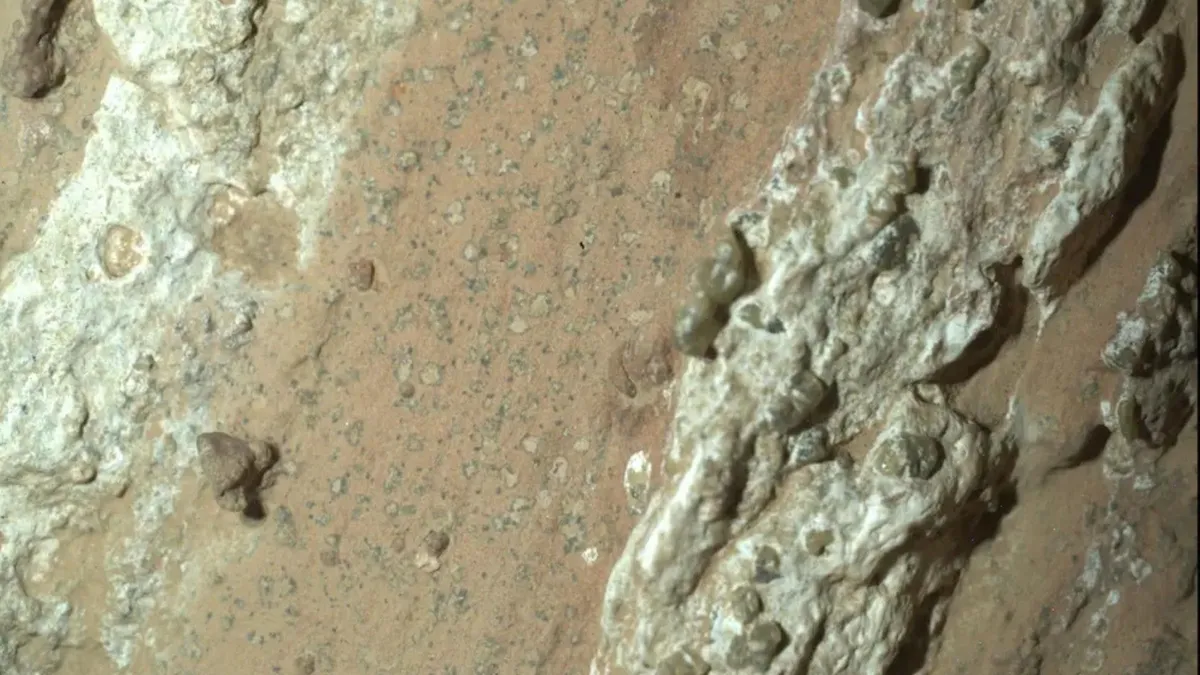
While Mars has yet to provide definitive proof of life, it has presented scientists with a fascinating new mystery. At the western edge of Jezero Crater, NASA's Perseverance rover is exploring an ancient river-carved valley known as Neretva Vallis, which once fed a vast Martian lake. Among the intriguing discoveries is a striking arrowhead-shaped rock nicknamed Cheyava Falls. This formation is unique, adorned with tiny black flecks resembling poppy seeds and distinctive leopard spots. Subsequent analysis revealed that these markings are rich in organic carbon, iron, phosphorus, and sulfur, hinting at complex chemical processes.
Recent reports from scientists have highlighted the presence of two significant minerals at Cheyava Falls: vivianite (an iron phosphate) and greigite (an iron sulfide). On Earth, these minerals typically form through redox reactions—essential electron-swapping processes vital for life. For instance, plants utilize redox in photosynthesis, while animals extract energy through respiration. Microbes also leverage these reactions to breathe metals in oxygen-starved environments, such as deep-sea vents. Thus, these chemical signatures often serve as biological markers on our planet, but on Mars, they remain tantalizing possibilities, hinting at either life or purely non-living processes.
Whatever their origins, these findings mark a significant departure from the chemistry typically observed on the Red Planet. Joel Hurowitz, a geoscientist at Stony Brook University and leader of the recent study, emphasized the uniqueness of this chemistry compared to the past 20-25 years of Martian exploration. Even if these reactions are ultimately non-biological, they could reveal prebiotically useful chemistry previously unconsidered. They also remind scientists of how abiotic processes can mimic life's signals, presenting challenges in interpreting potential biosignatures.
The surface of Mars usually narrates a tale of oxidation, with iron reacting with oxygen billions of years ago when liquid water and a thicker atmosphere were present. However, at Cheyava Falls, the Perseverance rover identified minerals that formed via reduction, where iron and sulfur gain electrons instead of losing them. These redox reactions are particularly intriguing because they tend to proceed slowly at low temperatures, making them excellent energy sources for life. According to Mike Tice, a geobiologist at Texas A&M University, the presence of redox chemistry on Mars raises the possibility that similar processes could have once supported life.
The search for ancient rocks exhibiting the chemical fingerprints of redox reactions is pivotal for uncovering signs of past life. Tice notes that the distinct presence of greigite in the leopard spots of Cheyava Falls is particularly compelling. Abiotic sulfide production at low temperatures is exceedingly slow, suggesting a potential biological origin for these minerals. The lack of heat or pressure alteration in the rocks, despite their age of over 3.5 billion years, adds to the intrigue, keeping open the possibility of a biological source.
The Bright Angel formation at Cheyava Falls also appears chemically dissimilar to other rocks in Jezero Crater. It showcases an unusually oxidized profile, stripped of elements like magnesium and calcium, resembling soils on Earth that have undergone extensive weathering. Hurowitz notes that this distinct profile reflects significant shifts in Mars' climate and atmosphere as Jezero Crater was filled with sediment. The findings suggest that Mars may have experienced considerable climate variability while still capable of supporting potentially habitable environments.
Perseverance has already drilled a core from Cheyava Falls and cached it for future analysis on Earth. Scientists eagerly anticipate the findings from NASA's Mars Sample Return (MSR) mission, which will allow for in-depth examination of the rock samples, something not possible aboard the rover. Hurowitz expressed a keen interest in conducting isotopic measurements of the sample to compare lighter and heavier versions of iron, sulfur, and carbon, hoping to determine whether biology played a role in the formation of redox minerals.
The search for evidence of life on Mars is evolving. Tice reflects on how, just two years ago, he felt there was insufficient information to discuss the possibility of life on Mars meaningfully. Previous missions indicated that Mars could have supported life billions of years ago, but did not provide conclusive evidence. Now, with Perseverance's findings, scientists are beginning to uncover the first hints of potential life, generating excitement for future exploration and study. Tice likened this moment to treasure hunting, where the discovery of something shiny compels further investigation.